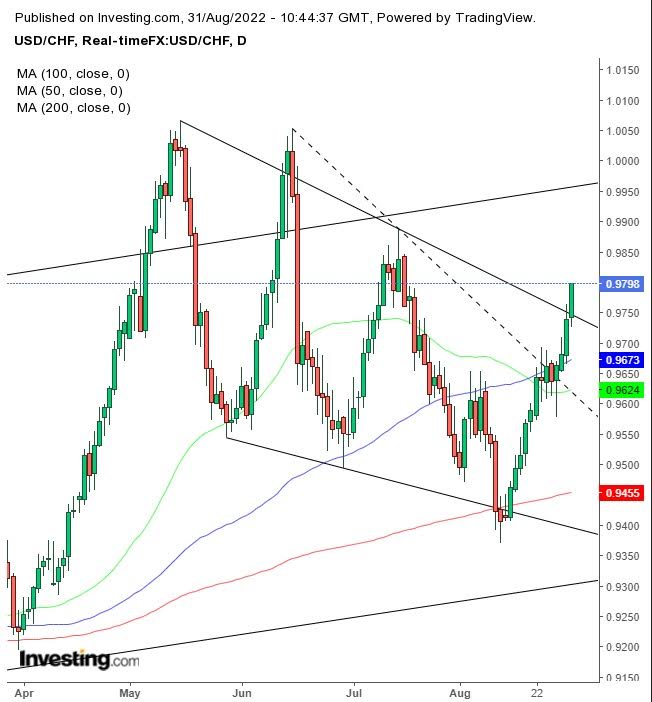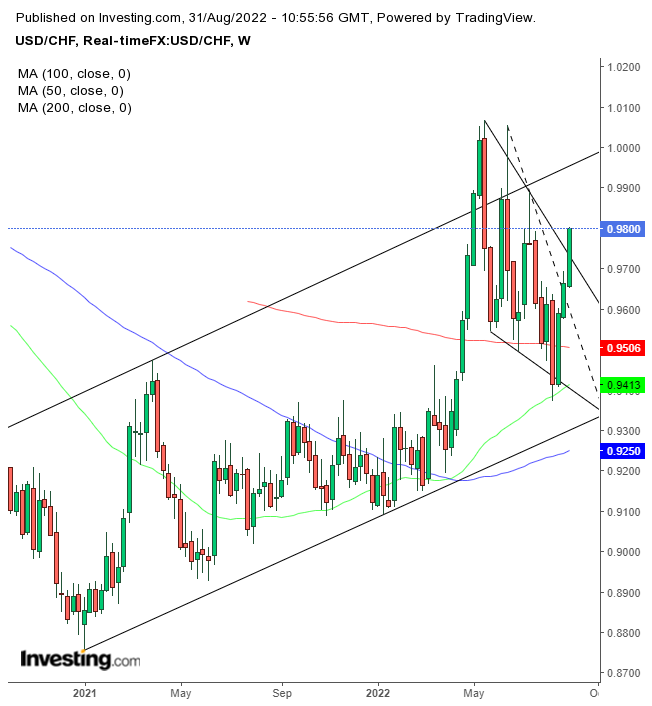The dollar rose for the fourth straight day to a 6-week high against the Swiss franc. The Swissy is also at a four-week low against the euro and the loonie. While the CHF is hovering at a two-month low versus the Aussie, even as Australia's economy is on course for its slowest growth ever outside of a recession.
The Swiss franc's demise correlates with the KOF Economic Barometer's downtrend. This exhaustive composite indicator reliably predicts the country's GDP trajectory. Note to all technical analysis haters, this entirely accepted economic indicator uses price trends. On top of that, Swiss National Bank President Thomas Jordan warns high inflation may stick for years to come.
Whatever the case, there is an extremely dollar-positive interest rate differential: -0.25% in Switzerland compared to 2.25-2.50% in the US. Also, the SNB is not pressing the interest rate pedal as hard as the US Federal Reserve. The one caveat is intervention for which the SNB is known. SNB President Thomas Jordan said that policy makers have not ruled out an intervention “in both directions so that we can buy or sell foreign currency if necessary.”
Let's see how all this translates into the forces of supply and demand.
The USD/CHF completed a falling wedge. The breakout included the price penetration of the 50 and the 100 daily moving averages (DMAs) after the 200 DMA supported the pattern low. The failure rate is between 2% and 10%, meager. However, pullbacks occur at about 50%. So, work that into your strategy.
Note the two different wedge top variations. Purists might argue that the dotted line is more accurate, as it includes all the price action within the structure. However, I think that a solid trendline, which consists of an additional, substantial rally, will impact trading as it includes significant interest, even if it doesn't align precisely with the trendline. This example is where experience overshadows textbooks. The difference between the interpretation is not academic but determines pattern completion.
Let's turn to the weekly chart.
We can see the significance of the solid, more meaningful weekly high at the expense of including the long upper shadow in the next peak.
Also, in this view, we can appreciate the placement of the wedge as a continuation pattern within the rising channel since the Jan 2021 bottom. In rare form, we discover that, like the 200 DMA, the 200 weekly moving average (WMA) supports the range. The 100 WMA realigned with the channel, and the 50 WMA is heading for a weekly Golden Cross.
Trading Strategies
Conservative traders should wait for a return move that confirms support.
Moderate traders would wait for the pullback for a better entry.
Aggressive traders can buy if they accept whipsaws.
Trade Sample - Aggressive Long
- Entry: 0.9700
- Stop-Loss: 0.9600
- Risk: 100 pips
- Target: 1.0000
- Reward: 300 pips
- Risk-Reward Ratio: 1:3
Disclaimer:The author currently does not own any of the securities mentioned in this article.



